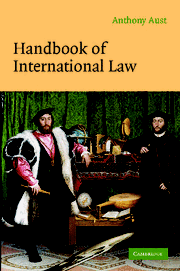Book contents
- Frontmatter
- Contents
- Foreword
- Preface
- Acknowledgments
- Table of treaties
- Table of MOUs
- Table of cases
- Glossary of legal terms
- List of abbreviations
- 1 International law
- 2 States and recognition
- 3 Territory
- 4 Jurisdiction
- 5 The law of treaties
- 6 Diplomatic privileges and immunities
- 7 State immunity
- 8 Nationality, aliens and refugees
- 9 International organisations
- 10 The United Nations, including the use of force
- 11 Human rights
- 12 The law of armed conflict (international humanitarian law)
- 13 International criminal law
- 14 Terrorism
- 15 The law of the sea
- 16 International environmental law
- 17 International civil aviation
- 18 Special regimes
- 19 International economic law
- 20 Succession of states
- 21 State responsibility
- 22 Settlement of disputes
- 23 The European Union
- Index
10 - The United Nations, including the use of force
Published online by Cambridge University Press: 05 August 2012
- Frontmatter
- Contents
- Foreword
- Preface
- Acknowledgments
- Table of treaties
- Table of MOUs
- Table of cases
- Glossary of legal terms
- List of abbreviations
- 1 International law
- 2 States and recognition
- 3 Territory
- 4 Jurisdiction
- 5 The law of treaties
- 6 Diplomatic privileges and immunities
- 7 State immunity
- 8 Nationality, aliens and refugees
- 9 International organisations
- 10 The United Nations, including the use of force
- 11 Human rights
- 12 The law of armed conflict (international humanitarian law)
- 13 International criminal law
- 14 Terrorism
- 15 The law of the sea
- 16 International environmental law
- 17 International civil aviation
- 18 Special regimes
- 19 International economic law
- 20 Succession of states
- 21 State responsibility
- 22 Settlement of disputes
- 23 The European Union
- Index
Summary
… measures commensurate with the specific circumstances as may be necessary …
Goodrich, Hambro and Simons, Charter of the United Nations, 3rd edn, New York, 1969
Bailey and Daws, The Procedure of the United Nations Security Council, 3rd edn, Oxford, 1998
Simma (ed.), The Charter of the United Nations, 2nd edn, Oxford, 2002
The United Nations was established by its Charter of 26 June 1945. Membership is open only to states. By the end of 2004, there were 191 Members, virtually all the states of the world.
Membership
The fifty-one original Members did not have to satisfy the criteria for membership (Article 3). They included India, which did not become independent until 1947, and the Byelorussian Soviet Socialist Republic (now Belarus) and the Ukrainian Soviet Socialist Republic (now Ukraine), both of which were only republics of the Union of Soviet Socialist Republics and did not become independent until 1991. The membership of these three was the result of a political deal at the San Francisco Conference.
New applicants for membership have had to satisfy the criteria in Article 4: an applicant must be a state, be peace-loving, accept the obligations in the Charter and, in the judgment of the Organization, be able and willing to carry out the obligations of membership. The first criterion is essentially legal, whereas the other three are more subjective and political, and no longer cause problems. The attributes of statehood have been discussed earlier.
- Type
- Chapter
- Information
- Handbook of International Law , pp. 205 - 232Publisher: Cambridge University PressPrint publication year: 2005



